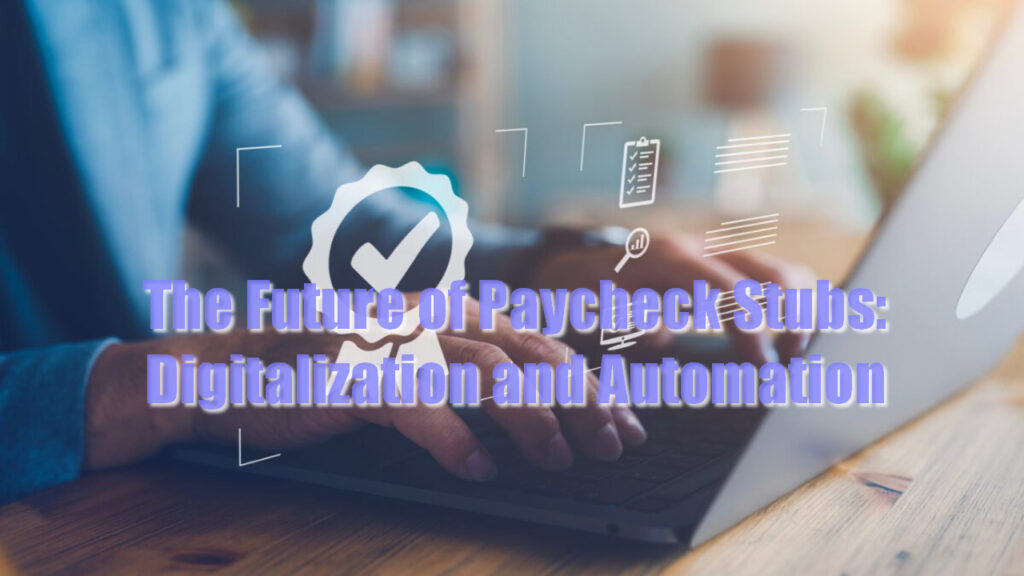In today’s rapidly advancing digital age, technology has transformed numerous aspects of our lives, including the way we work and get paid. One area that is undergoing a significant transformation is the generation and distribution of paycheck stubs. Traditionally, paycheck stubs were printed on paper and handed out to employees along with their physical paychecks. However, with the rise of digitalization and automation, the future of paycheck stubs is moving towards a more streamlined and efficient process. This article explores the potential future of paycheck stubs, focusing on digitalization and automation as the key drivers of change.
Embracing the Paperless Era

As more and more organizations adopt digital workflows, the shift towards paperless paycheck stubs becomes increasingly evident. Digitalization offers numerous benefits, such as cost savings, improved efficiency, and reduced environmental impact. By replacing paper paycheck stubs with digital equivalents, companies can eliminate printing and distribution costs, saving both time and money. Additionally, with generators like PayStubCreator, digital paycheck stubs can be securely stored and easily accessed by employees whenever needed, eliminating the hassle of physical document management.
Streamlining Payroll Processes
Automation is another key factor driving the future of paycheck stubs. With the integration of payroll software and advanced algorithms, the process of generating and distributing paycheck stubs can be streamlined and made more accurate. Automated payroll systems can calculate wages, deductions, and taxes with precision, minimizing errors and ensuring compliance with legal and regulatory requirements. This not only saves time for payroll administrators but also reduces the likelihood of mistakes that could lead to financial discrepancies or legal issues.
Enhanced Employee Access and Engagement

Digitalization and automation of paycheck stubs also improve employee access and engagement. By providing online portals or mobile applications, employees can securely access their digital paycheck stubs anytime and from anywhere. This convenience empowers employees to review their pay information, track earnings and deductions, and monitor their financial progress more effectively. Furthermore, digital paycheck stubs can be easily integrated with personal finance management tools, allowing employees to analyze their spending habits, create budgets, and plan for the future with greater ease.
Data Analytics and Insights
The digitization of paycheck stubs opens up opportunities for data analytics and insights. By aggregating and analyzing payroll data, companies can gain valuable information about employee compensation, benefits, and trends. This data can be used to identify patterns, optimize resource allocation, and make informed decisions regarding employee compensation and benefits packages. Moreover, data-driven insights can help organizations identify potential issues, such as pay disparities or anomalies, and take corrective actions to ensure fairness and transparency.
Data Security and Privacy Considerations

As paycheck stubs move into the digital realm, data security, and privacy become paramount concerns. Companies must implement robust security measures to protect employee information from unauthorized access and cyber threats. Encryption, multi-factor authentication, and regular security audits are essential components of a comprehensive data protection strategy. Additionally, organizations must comply with data privacy regulations, such as the General Data Protection Regulation (GDPR) in Europe or the California Consumer Privacy Act (CCPA), to safeguard employee privacy rights.
Transition Challenges and Adoption Strategies
While the future of paycheck stubs is undeniably digital, the transition from traditional paper-based systems to digital platforms may present challenges for some organizations. Resistance to change, lack of technological infrastructure, and employee training requirements are a few obstacles that need to be addressed. To facilitate a smooth transition, organizations can provide comprehensive training programs, seek employee feedback, and gradually phase out paper stubs while ensuring the availability of digital alternatives.
The future of paycheck stubs lies in digitalization and automation. As companies embrace technology-driven solutions, the benefits of paperless stubs, streamlined processes, enhanced access and engagement, data analytics, and improved data security become increasingly apparent. While challenges may arise during the transition, organizations can overcome them by investing in the necessary infrastructure, training, and change management strategies. The future of paycheck stubs is poised to revolutionize payroll processes, empower employees, and drive greater efficiency and accuracy in the world of work.
